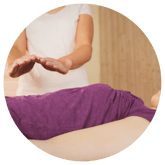Reiki is an alternative form of energy healing that traces its origins to ancient Chinese and Japanese medicine practices. The term itself is a combination of the Japanese words "rei" (meaning "universal") and "ki" (meaning "life energy"). Taken together, these words form the term "Reiki," which means universal life force energy — or the energy that's believed to be present in every living being.
Today, Reiki is typically used as a complement to traditional medical treatment. Many believe that Reiki promotes the body’s natural healing properties.
Table of Contents
How Does Reiki Work?
Reiki therapy works by the practitioner using light touches to guide the way energy flows throughout the recipient’s body. The practitioner doesn’t cause the healing, nor are they generating energy. Instead, they serve as conduits that guide Reiki energy to the places in the body where it’s most needed.
In studying Reiki, students learn different techniques from a master-level Reiki practitioner — who serves as a teacher or sensei. While Reiki is generally considered a spiritual practice similar to meditation, many Reiki healers collaborate with medical schools and other traditional medical practitioners to better understand how it works. Despite its inclination toward the spiritual, Reiki is not separate religion and should not be viewed through that lens.
Anyone interested in learning more about Reiki treatment should begin by acknowledging and accepting the existence of a universal life force energy. This energy — called "ki" in Japanese, as mentioned above, and often referred to as "chi" in Chinese — underlies everything in existence. That chi or ki gets organized into multiple energy systems. Each system interacts with one another, from person to person, and between a person and their environment.
Many illnesses and ailments within the human body are thought to result from imbalances in a person’s energy. Reiki therapy helps correct those issues by realigning the flow of energy along an ideal path. Practitioners often work down the chakras or energy points that run along the spine.
What Are the 5 Central Elements of Reiki?
There are five elements practitioners rely on when channeling Reiki energy:
- Attunements or initiations. These are situations where a Reiki master teaching a student passes along Reiki energy.
- Hand positions. These are used by Reiki practitioners during a session to manipulate energy.
- Meditation. The process of connecting with the universal Reiki source to focus energy healing.
- Symbols. Reiki symbols represent a purpose for practicing Reiki. They help practitioners connect to higher levels of energy healing.
- Principles. The five Reiki principles represent the philosophy of Reiki and help guide healing and energy balance.
What Are the Methods Used in Reiki?
Reiki healers use various traditional and fundamental hand positions to balance energy and encourage energy flow within the body. The amount of time they spend on different body areas will vary depending on a person’s specific issues. Below are examples of popular hand positions typically used by a Reiki practitioner, with the recipient lying on their back:

Palm on the head. The practitioner lightly places the palms of their hands over a person’s forehead. They may also gently cup the recipient’s eyes.

Hands on the side of the head. The Reiki healer places their hands along the sides of a person’s face and temples.

Head cradled. The practitioner cradles a person’s head in both hands while resting on the table beneath them.

Jaw and throat. The Reiki healer applies light touches to a person’s jaw and throat.

Neck and chest. The practitioner places one hand over a recipient’s neck or collarbone area while the other hovers around the person’s heart chakra around the center of their chest.

Upper abdomen. The Reiki healer places their hands on a person's upper abdomen.

Solar plexus. The practitioner places their hands on a recipient’s mid-abdomen or solar plexus.

Lower abdomen. The Reiki healer places their hands on a person’s lower abdomen below the recipient’s navel.
Depending on an individual’s ability to move into different positions, a Reiki practitioner may recommend moving that person into a specific position where they're on their knees or stomach. It all depends on what position the Reiki healer feels will best serve the client’s needs.
What Are the Health Benefits of Reiki?
Reiki treatment has been shown to help with relaxation. Many have reported feeling better mentally, both physically and emotionally, after a session.
While current studies are inconclusive when it comes to proving the benefits of Reiki healing, there is anecdotal evidence that it helps people dealing with stress and other emotional difficulties. Conditions that people have sought out Reiki therapy for include:
- Anxiety
- Cancer
- Chronic pain
- Depression
- Fatigue
- Heart disease
It’s recommended that individuals use Reiki healing in conjunction with recommended medical treatments.
What Questions Should You Ask a Reiki Practitioner?
.png?width=800&name=interior%203000%20x%201500px%20(1).png)
People should feel free to ask a Reiki practitioner questions about their practice. However, it’s always good to get independent verification about the level of services they provide.
As with any form of medical treatment, those seeking Reiki treatment should always do additional research on the background, credentials, and overall history of the Reiki practitioner. Before working with a practitioner, it's important to ask them the following:
- What level of Reiki training do you have?
- Where were you trained?
- How long did you spend mastering various levels of Reiki?
- How much clinical experience have you had using Reiki to treat my issue?
Listen carefully to the answers provided by the practitioner. If they don’t appear to have the background or experience necessary, then you can continue searching. Many Reiki practitioners expand their knowledge by spending time in different health and wellness environments. You may be able to ask for references or find some of the practitioner’s previous clients.
How Can You Find a Reiki Practitioner?
People can turn to their circle of friends. One of your friends might consult with a Reiki practitioner or may already be one themselves. A friend that’s familiar with Reiki can recommend qualified Reiki healers. If they are practitioners, they might offer Reiki treatments, too! People can also look for those associated with healthcare facilities or medical schools. Trusted doctors can be a good resource for recommendations of people who provide Reiki services.
Sofia Health is an excellent source, too. We help connect people to Reiki masters and other health and wellness professionals capable of helping clients deal with specific spiritual, mental, physical, and emotional issues. Visit Sofia Health to start searching for a Reiki healer today.







